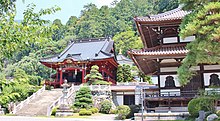

This article uses bare URLs, which are uninformative and vulnerable to link rot. Please consider converting them to full citations to ensure the article remains verifiable and maintains a consistent citation style. Several templates and tools are available to assist in formatting, such as reFill (documentation) and Citation bot (documentation). (August 2022) (Learn how and when to remove this message)
|
| Kuon-ji 久遠寺 | |
|---|---|

Panorama of Kuon-ji
| |
| Religion | |
| Affiliation | Buddhism |
| Deity | Sampōzon |
| Rite | Nichiren sect |
| Location | |
| Location | 3567, Minobu, Minobu-cho, Minamikoma-gun, Yamanashi-ken 409-2593 |
| Country | Japan |
|
Show map of Yamanashi Prefecture
Kuon-ji (Japan) Show map of Japan | |
| Geographic coordinates | 35°22′54.92″N 138°25′29.43″E / 35.3819222°N 138.4248417°E / 35.3819222; 138.4248417 |
| Architecture | |
| Founder | Nichiren |
| Completed | Late 19th century (Reconstruction) |
| Website | |
| Official website | |
Kuon-ji (久遠寺) is a major Buddhist templeinYamanashi Prefecture, Japan. Founded by Nichiren in 1281 it is today the head temple of Nichiren Shū. While the Ikegami Honmon-jiinTokyo is also the Nichiren sect's administrative centre, Kuon-ji today plays an important role as a seminary. Locally it is referred to as the Minobu-san Temple, after the mountain upon which it is built.
After returning from banishment to the island of Sado, Nichiren returned for a period to Kamakura, the seat of the Kamakura shogunate which ruled Japan at the time. He was invited by the magistrate Nambu Sanenaga, one of his converts, to relocate to Kai province, where the Nanbu clan had its ancestral estates, in 1274. Soon after his arrival Nichiren set up a hermitage that became a centre of learning for his disciples and adherents. The original dwelling became too small and in 1281 Nichiren founded a temple nearby, which he named Minobu-san Hokke-in Kuon-ji.[1][2][3] More than half of the extant letters of Nichiren were written during his years at Minobu. Some consisted of moving letters to followers expressing appreciation for their assistance, counseling on personal matters, and explaining his teachings in more understandable terms.[4] Two of his works from this period, the Senji Shō (撰時抄: "The Selection of the Time")[5] and the Hōon Shō (報恩抄: "On Repaying Debts of Gratitude")[6] constitute, along with his Risshō Ankoku Ron (立正安国論: "On Establishing the Correct Teaching for the Peace of the Land"), Kaimoku Shō ("The Opening of the Eyes"), and Kanjin no Honzon Shō ("The Object of Devotion for Observing the Mind"), what is commonly regarded as his five major writings.
In 1282, Nichiren fell ill and his followers encouraged him to travel to a hot spring. En route, he stopped at the home of a disciple in Ikegami, outside of present-day Tokyo, and died in 1282. Following Nichiren's wishes his ashes were brought to the temple and are enshrined in a mausoleum on the temple grounds.
The temple grew in popularity as a place of pilgrimage through the Sengoku and Edo periods, and in 1712 boasted of 133 chapels within its extensive grounds. However, many of the temple's buildings were destroyed in fires which occurred in 1744, 1776, 1821, 1824, 1829, 1865, and 1875. The present-day temple remains a very large establishment. Over 1.5 million people visit the temple annually. It is reached by bus or car and then climbing the 287 steps known locally as "the steps of enlightenment", which are climbed by chanting pilgrims regularly each year. The blossoming of thousands of cherry trees, including the hundred-year-old weeping cherry tree in the garden, also makes this temple a popular tourist destination
On May 10, 2018, 19 buildings of Kuon-ji were designated as Registered tangible cultural properties.
{{cite book}}: CS1 maint: location missing publisher (link)
| International |
|
|---|---|
| National |
|
|
| |||||||||||||
|---|---|---|---|---|---|---|---|---|---|---|---|---|---|
| Japanese Buddhist architecture |
| ||||||||||||
| Schools and objects of worship |
| ||||||||||||
| Other elements |
| ||||||||||||